Here's a list of Louis Navellier's stock picks that we've been exposing. We'll do our best to keep it up-to-date.
To make this list more convenient, I'll be adding his latest picks that we've covered to the top so that you don't have to scroll down so far 🙂
Table of Contents
- 2025 Picks
- 2024 Picks
- 2023 Picks
- 2022 Picks
- 2020 Picks
- Who Is This Louis Navellier Guy Really?
- Conclusion & Should You Buy Louis' Recommendations?
2025 Picks
His “Trump Shock” Stocks
- Title of Teaser Presentation: “The $7 Trillion Trump Shock is coming…”
- Name of “Special” Reports: “The $7 Trillion Trump Shock: 5 Stocks Poised to Surge 1,000%”
- Promoted Under: Accelerated Profits
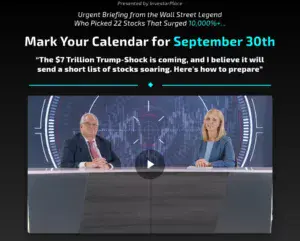
What a tidy story he has: on September 30 (fiscal year-end) a $7T wall of “cash on the sidelines” starts to move, and a tiny group of AI-beneficiaries will soak it up while the rest of the market lags. The macro scaffolding here is familiar—the well-documented late-September federal spending rush and record money-market balances—and it’s being used to funnel attention into five of his handpicked stocks.
First, the clues Navellier drops—before any tickers:
- A “tiny” company with the largest U.S. rare-earth land package, already aligned with 2025 exploration tied to White House directives.
- An online auto platform using AI to let customers shop and take delivery from home; he compares its model to “riding the industry’s growth” rather than manufacturing.
- An engine maker whose lineup spans forklifts to construction equipment—and newly, data-center applications—with a recent >700% stake increase from Citadel flagged.
- A power-infrastructure firm building turnkey natural-gas plants and critical infrastructure for utilities, energy firms, and public-private projects.
- An avionics supplier of flight-deck systems, sensors, comms and navigation with Pentagon and Tier-1 aerospace customers, claimed to be around a $250M market cap.
- “Bonus”: one more electronics manufacturer tied to defense/compute supply chains.
Match the clues to the reveals and you get: Idaho Strategic Resources (IDR) for the rare earths angle; Carvana (CVNA) for the AI-driven car-shopping/delivery platform; Power Solutions International (PSIX) for engines including data-center gensets; Enerflex for turnkey gas-fired plants and related infrastructure; Astronics (ATRO) for avionics and defense customers (though the $250M cap clue is outdated—shares have run and it’s now well north of that); and a “bonus” in TTM Technologies (TTMI).
Does the September 30 “shock” justify 10x claims? The date is real as a federal catalyst (fiscal year ends and “use-it-or-lose-it” contracting is a thing), and the White House’s United States Investment Accelerator exists to speed >$1B projects (think permitting shepherding), but that’s a flow-through tailwind, not a magic wand for multi-baggers.
Overall read: two ideas here plausibly ride structural demand (domestic rare earths via IDR; data-center/industrial engines via PSIX). The others range from momentum-sensitive (CVNA’s premium valuation) to capital-intensive infrastructure (Enerflex) to cyclical avionics (ATRO) with timing risk. The “$7T” framing is more about narrative gravity than guaranteed upside—useful for attention, not a thesis by itself.
>> Read the full write-up here
“AI Mineral Stocks” and the MAGA Fund
- Title of Teaser Presentation: “The MAGA Investment Fund”
- Name of “Special” Reports: “The Top Three Companies Being Fast-Tracked by President Trump”
- Promoted Under: Growth Investor

Louis Navellier is back with a fresh angle: a White House–backed “MAGA Fund” that will pour money into U.S. natural resources tied to the AI buildout—promising 200%–450% gains “in months.” The setup mixes two narratives he loves: state-driven catalysts and hard-asset bottlenecks, similar in tone to his earlier AI “Master Key” pitch. The hook this time is that a little-known federal body—the Federal Permitting Improvement Steering Council—has “emergency status” momentum to fast-track critical projects, turning permitting timelines from years into weeks.
First, the clues he drops before any tickers:
- Projects already granted “emergency status,” with Pentagon or federal backing.
- One company owns the only domestic source of a specific rare earth critical for military ammunition and flame retardants, and has nearly $2B of U.S. export-credit financing in motion.
- Another is a sub-$5 stock using direct lithium extraction (DLE) in Arkansas.
- A third controls one of the largest undeveloped silver-copper assets in the U.S., is a large, dividend-paying miner, and posted ~30% sales growth last year.
- A “freebie” was named outright: MP Materials—the rare earths producer expanding into U.S. magnets with Pentagon help.
Match the clues to the reveals and it lines up like this:
- The “only domestic source” rare earth with DoD relevance is antimony, pointing to Perpetua Resources (PPTA). Perpetua formally applied for up to $2B in debt financing from the U.S. Export-Import Bank to build the Stibnite antimony-gold project in Idaho—exactly the financing breadcrumb Louis cites.
- The sub-$5 Arkansas DLE play is Standard Lithium (SLI), which has been advancing Smackover-brine DLE projects and secured a large U.S. grant with a major partner—consistent with the “new tech + Arkansas” framing.
- The big, dividend-paying copper/silver owner with a long dividend streak is BHP (BHP), whose Resolution Copper JV in Arizona is one of the largest undeveloped copper deposits in North America—fitting the “large, established, dividend payer” clue.
- And the teaser’s appetizer is MP Materials (MP), which recently announced a public-private partnership with the DoD to scale U.S. rare-earth magnets—exactly the type of government “MAGA Fund” tailwind Navellier highlights.
Why the urgency motif? The obscure-sounding council Louis references is real: the Permitting Council was established to make federal permitting “transparent, predictable, and accountable” for major projects, and it has become a key venue for accelerating energy and minerals infrastructure—i.e., the policy lever his thesis leans on.
Big picture, this is the same playbook we see across “critical minerals” teasers—think defense ties and fast-tracked permits like in Dylan Jovine’s rare-earths pitch. Here the breadcrumbs are tighter than usual: Perpetua’s EXIM application is public; SLI is the obvious DLE-in-Arkansas microcap; Resolution Copper is BHP’s marquee U.S. growth option; and MP got fresh DoD backing. The sovereign-fund branding is new, but the mechanism—Washington throwing weight behind minerals for AI-era infrastructure—is well-documented government policy, not magic.
Two useful context reads while you vet the story: the Permitting Council’s own description of its mandate, which explains the “fast-track” backbone Louis leans on, and Reuters’ coverage of Perpetua’s EXIM loan application, which is the specific funding clue that narrows pick #1.
>> Read the full write-up here
Next Generation AI Stocks
- Title of Teaser Presentation: “The Next Mania Is Coming”
- Name of “Special” Reports: “The Real AI Boom: Six Stocks That Could Multiply Your Money in The Next Generation of AI”
- Promoted Under: Breakthrough Stocks

I suppose this teaser was released in 2024 since it says “Prediction 2024”. Nonetheless, he's still teasing the heck out of it and we've not gotten around to covering it until now.
He says the last big mania of his career is about to kick off—and it won’t be in chips or chatbots. His pitch: the real money is in companies that use AI to automate existing work, not those that sell the shovels.
Here are the clues he drops before any ticker shows up:
- One pick was supposed to be revealed for free—but the video “skips” right as the name flashes.
- Another combines AI + biotech to speed drug discovery (fits small/mid-cap; also held by Navellier & Associates).
- A third is a platform for AI apps, essentially letting different LLMs “talk” to each other—framed like an IoT-for-AI backbone.
- A fourth is an online dating company using AI to refine matches based on past swipes (limited public players; one is leaning hard into AI features lately).
- Macro rationale: widespread automation potential—Goldman Sachs has floated “two-thirds of jobs” being exposed to some degree of AI, with large productivity upside.
Working from those breadcrumbs, the exposé narrows likely candidates to:
- Exelixis (EXEL) for the AI-assisted drug discovery angle (lands in his small/mid-cap lane and appears in his firm’s holdings).
- Samsara (IOT) for the connected-operations/“IoT for AI” platform vibe.
- Match Group (MTCH) for the dating-app AI push (Tinder/Hinge testing AI features to boost engagement).
Price of admission? The six names sit inside the report above, locked behind a Breakthrough Stocks subscription—list $4,000, “discounted” to $1,799 for year one. Meanwhile, he also names stocks to avoid (Pfizer, Intel, Warner Bros. Discovery, UPS, plus regional banks) on the claim they’re lagging his eight-factor model and AI integration.
Bottom line is this: the theme (AI-enabled automation) is real enough—Goldman’s own work pegs meaningful productivity gains alongside job exposure—but the teaser gives thin, generic clues and leans on back-tested “grader” swagger (Louis is good at not giving us enough to sleuth out his picks). Before chasing “next-gen” AI adoption stories, sanity-check unit economics (cash burn, customer concentration) and whether the AI feature is actually moving the P&L, not just the press releases.
>> Read the full write-up here
His “Trump/AI Convergence” Stocks
- Title of Teaser Presentation: “The $100,000 Trump/AI Convergence Project”
- Name of “Special” Reports: “5 Trump/AI Convergence Growth Stocks to Buy Right This Second”
- Promoted Under: Accelerated Profits
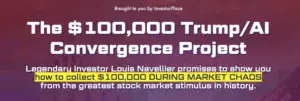
Here we have Navellier and host Lauren Sivan pitching a “new way to collect regular cash payouts” from stocks at the intersection of Trump-era pro-growth policy and the AI boom. The sell is classic Navellier: a proprietary, predictive-analytics-driven system that hunts for “obscene earnings and sales growth,” trades actively (intra-month), and targets smaller names using AI across non-tech industries. Think momentum plus quant screens — essentially what most would call predictive analytics wrapped in a brand name. The hook: a $1,799 Accelerated Profits subscription and a “$100k performance promise.”
Here are the actual clues dropped in the teaser before any tickers:
- It’s not options or dividends; the “income” comes from intra-month stock trades keyed off momentum.
- Focus on smaller companies applying AI to operations (examples shown: ZTO Express; Vermilion Energy).
- The macro pitch ties AI adoption to a rising tide of multi-baggers, plus a policy tailwind (the “Trump” part).
That’s it for hard clues — no contracts, no locations, no financial metrics tied to a specific company. So we followed the bread crumbs: Navellier & Associates’ latest 13F. The newest positions that fit the “AI + momentum” brief best (and thus the likely candidates behind the curtain) are:
- AppLovin (APP) — adtech with heavy ML/AI optimization baked into its engine; a textbook momentum face-ripper when the algo hits.
- Doximity (DOCS) — a vertical network for physicians leaning on data/AI to match ads and workflow tools.
- Atmos Energy (ATO) — not “AI” per se, but squarely in the AI infrastructure slipstream as power demand climbs. The AI/data-center surge has U.S. electricity use set to notch records in 2025–26.
- Kinross Gold (KGC) — a classic resource hedge that also benefits when “picks-and-shovels” cyclicals lead during capex waves.
To be clear, these are inferred from his firm’s fresh buys — not revealed in the video… since he's stingy about giving out clues — but they line up with the theme and with how Navellier runs money. And the “income strategy” is just short-cycle momentum trading using his quant ratings, not some new cash fountain. We’ve seen Navellier frame AI as a “master key” before, too — different branding, same quant-plus-momentum playbook.
Bottom line: the pitch is more about process (predictive screens + momentum) than about a single breakthrough stock. If you buy the premise, the names above reflect the kind of exposure he’s likely pushing — with an extra nod to energy and resources as the underloved enablers of AI’s power hunger.
>> Read the full write-up here
AI Proliferation Stocks
- Title of Teaser Presentation: “My biggest prediction in 47 years…”
- Name of “Special” Reports: “12 ‘Must Own’ Stocks for AI’s Proliferation Boom”
- Promoted Under: Growth Investor
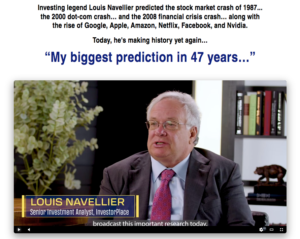
Louis Navellier frames this as a coming “rupture” in the market—AI isn’t just minting winners; it’s also exposing laggards. The pitch says we’re moving into an AI proliferation phase where companies that apply AI (not just build chips or models) will take disproportionate share. Think GoDaddy using AI to juice profitability rather than designing GPUs. The macro view is familiar: consultants still float the idea that AI could add roughly $15.7 trillion to global GDP by 2030, and you can already see knock-on effects in the real world—data-center construction is hitting records as AI demand surges, per recent Reuters reporting.
Here’s the issue: InvestorPlace gives no company-specific clues in this teaser—no contract numbers, locations, revenue ranges, or pricing tells. So there’s nothing to “solve” from the video itself. The write-up instead cross-references Navellier’s past preferences and public holdings to infer likely inclusions for the 12-stock list. Based on that:
- #1 pick likely Nvidia (NVDA) — long flagged as Navellier’s decade pick and a top firm holding; fits the “proliferation” backbone thesis.
- EMCOR Group (EME) — a pragmatic way to play the AI build-out via mechanical/electrical contractors for data centers.
- Costco (COST) — poster child for old-line operators quietly embedding AI (inventory, pricing, logistics, even store ops).
- Axon Enterprise (AXON) — applying AI to policing (e.g., automated license-plate recognition and body-cam analytics).
- Eli Lilly (LLY) — big-pharma example using AI for discovery and process automation; also lines up with Navellier’s disclosed large holdings.
To be clear, these names are educated speculation, not reveals from the teaser. The presentation itself provides zero breadcrumbs—no SKUs, contracts, or geography—to triangulate picks. The theme, however, is consistent: a barbell of (1) AI infrastructure enablers and (2) everyday operators who weaponize AI fastest.
>> Read the full write-up here
2024 Picks
His “QaaS” Stocks
- Title of Teaser Presentation: “Jeff Bezos' Next Trillion Dollar Bet”
- Name of “Special” Reports: “My #1 QaaS Stock: The Tiny Company About to Dominate the Coming $46 Trillion Disruption”
- Promoted Under: Growth Investor

Navellier is pitching “QaaS” — Quantum-computing-as-a-Service — as the next platform shift, with Bezos-backed quantum bets and breathless comparisons to AI. The promise: quantum will slash costs and crack problems that stump classical machines (Google’s 2019 demo famously solved a task in minutes that would take a supercomputer thousands of years). For background on the quantum side, Reuters covered Google’s “quantum supremacy” milestone, which is the kind of proof point marketers love to cite, even if practical use cases are still emerging.
Clues dropped before tickers:
- “QaaS” winner is a small Maryland-based firm, tied to DARPA and working with Amazon and Microsoft.
- Core hardware described as a patented ‘ion trapper’; pitch claims 32,000× more powerful than rivals.
- Bonus Pick #1: Austin, TX cybersecurity outfit; first to $1B of sales via AWS Marketplace.
- Bonus Pick #2: A 40+-year tech giant (cloud, software, gaming, hardware, search) that made a big QaaS move on Nov. 8, 2023.
How the reveals line up:
- The Maryland + DARPA + Amazon Braket combo narrows cleanly to IonQ (NYSE: IONQ). IonQ runs on Amazon’s Braket (AWS’s quantum service) and has been involved in DARPA’s quantum benchmarking efforts — exactly the kind of “QaaS” access the teaser describes.
- The Austin cloud-security name with the $1B AWS Marketplace milestone is CrowdStrike (NASDAQ: CRWD) — the company publicly trumpeted being the first cloud-native cybersecurity ISV to surpass $1B in AWS Marketplace sales.
- The Nov. 8, 2023 “massive investment into QaaS” points to Microsoft (NASDAQ: MSFT), which that day announced a strategic collaboration and investment in quantum-networking startup Photonic.
Bottom line: Navellier’s “QaaS” trio is IonQ, CrowdStrike, and Microsoft — a speculative pure-play (IONQ), a pricey but dominant security platform (CRWD), and a mega-cap infrastructure gatekeeper (MSFT). The clues fit neatly; just remember the gulf between lab buzz and durable revenues in quantum remains wide for now.
>> Read the full write-up here
2023 Picks
“A Phase” Stock Picks
- Title of Teaser Presentation: “This is My ‘Weekly Pay'”
- Name of “Special” Reports: “5 A-Phase Stocks to Buy Now”
- Promoted Under: Growth Investor
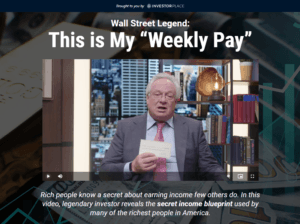
Here, we have Navellier bragging about how much he makes per week. He says the way to thrive in any market is to target stocks only when they enter an “A Phase” — his acceleration window when big money starts piling in and prices rip higher… and, of course, he promises us with five fresh “A Phase” picks with “absurd” income potential.
Here are the actual clues he drops before any tickers:
- He claims every stock cycles through Baseline → Acceleration (“A Phase”) → Ceiling → Decline and that the system is best for “very small stocks.”
- He hints at nine shared traits among “A Phase” names (four tied to earnings) and says institutional buying pressure is heavily weighted.
- He cites examples like Apple, Starbucks, Nvidia showing repeated life cycles, and Big 5 Sporting Goods ripping ~341% in 11 months after a late-2020 “A Phase” break.
- Beyond that? No company-specific breadcrumbs for the five new recommendations.
Because he withholds stock-level details, there’s no legitimate way to reverse-engineer the five names from the teaser alone — a common outcome in these “system” pitches. Without tickers, the only thing to analyze is the method and its real-world frictions.
A few reality checks: First, timing “acceleration” phases sounds great until you factor in taxes and turnover. Short-term gains are taxed at ordinary income rates, while long-term gains get 0%/15%/20% treatment — a structural headwind for rapid in-and-out strategies. See this plain-English explainer for the difference. Second, even pros struggle to beat simple indexes after costs; SPIVA’s long-running scorecards keep showing most active funds lag their benchmarks over time — the opposite of “house-edge certainty.”
Bottom line: the teaser sells a cycle-timing framework, not verifiable stock picks. The concept — buy strength as institutions accumulate — isn’t crazy, but the execution lives and dies on discipline, fees, spreads, slippage, and tax drag. If you’re tempted, treat it like any other high-churn strategy and compare it honestly to a boring index.
>> Read the full write-up here
$50k Cash Comeback Stocks
- Title of Teaser Presentation: “$50K Cash Comeback”
- Name of “Special” Reports: “Five ‘Accelerated-Income Generators’ That Can Hand You Five Massive Cash Payments!”
- Promoted Under: Accelerated Profits

Navellier (introduced by host Paul Ghiringhelli) pitches a short-term trading system built to crank out cash flow now—not years from now. The promise: follow his “$50k Cash Comeback” plan and you could pull an extra $50,000 over the next 12 months. It’s not dividends, options, bonds, or real estate. It’s a capital-gains strategy targeting stocks he says are poised to “explode” soon, found by scoring eight “income indicators.”
First, the clues he drops before naming anything:
- A rules-based screen that requires all eight boxes checked—positive earnings revisions, earnings surprises, sales growth, expanding operating margins, strong cash flow, earnings growth, earnings momentum, and high ROE. If a stock has seven, he “won’t even consider it.”
- Each indicator has a threshold (e.g., operating margins up at least 20% year-over-year; earnings growth ≥ 15%).
- He touts “50 payouts” in 2022 and shows Baozun (BZUN) as a case study that rallied ~159% after lighting up all eight indicators (used as an example, not a pick).
- The payout math is explicit: targeting ~$2,500 gains per ~$7,500 position (i.e., ~33% pops), repeated ~20 times to hit the $50k headline.
Only after those hints does he reveal one name from his five-stock list: Shoals Technologies Group (NASDAQ: SHLS), a solar balance-of-system supplier he says currently meets all eight signals and is “perfectly positioned” for a hefty short-term payout. (For context on the company/sector, see Reuters’ profile page for Shoals and its recent financials.)
What’s really being sold is a momentum screen dressed up as “income.” The eight indicators are essentially catalysts and quality-tilts that try to catch stocks mid-run after positive estimate revisions and earnings beats. That can work in bursts—but the other side of momentum is sharp reversals, slippage, and tax drag. As Investopedia puts it, momentum strategies are “buy-high, sell-higher” and are highly sensitive to timing and costs, making them unsuitable for many investors without tight risk controls and discipline. Likewise, hinging a system on earnings surprises assumes the market keeps rewarding beats—true sometimes, not always.
Bottom line: the “$50k” headline requires ~20 separate ~33% wins in a year—aggressive even in friendly tape. If you’ve followed Green Bull for a while, the structure will feel familiar—slick framing, tight “rules,” and a premium upgrade for the rest of the tickers.
>> Read the full write-up here
That “AI Master Key” Stock
- Title of Teaser Presentation: “The Artificial Intelligence ‘Master Key'”
- Name of “Special” Reports: “The AI Master Key”
- Promoted Under: Growth Investor
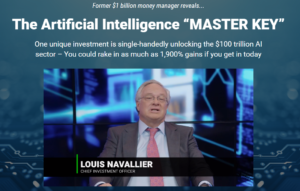
With this pick, Navallier’s angle is classic “picks-and-shovels.” He says the only sensible way to ride the AI boom isn’t buying the flashy platforms, but the one “Master Key” that everything in AI must use. He frames it like a digital toll road: as more AI apps spin up, this company gets paid.
Here are the actual clues he drops before revealing anything:
- It’s what “makes the AI revolution possible,” used by virtually every AI app.
- Its customer list includes Google, Microsoft, Amazon, and Alibaba.
- Well-known investors (Ron Baron, Ken Fisher, Mario Gabelli) hold big stakes.
- The stock has delivered roughly 76,229% since the early 2000s.
- He first urged readers to buy in May 2016.
- Marketed as a “backdoor” into the hottest private AI names because they all run on this “key.”
- Investable in any normal brokerage account in minutes (so, not a fund or private placement).
Put those together and the “AI Master Key” tees up as NVIDIA (NVDA). The fit is straightforward: NVIDIA’s GPUs are the workhorses of modern AI training and inference, and the firm has deep relationships across the cloud majors. Reuters has repeatedly noted NVIDIA’s dominant share of AI GPUs and why GPUs are the chips that actually make large-scale AI work in practice, thanks to their parallel math horsepower built for neural nets’ matrix operations. The “76,000%+ since 2000” also matches the long arc of NVDA’s split-adjusted climb. Add in the marquee customers and the institutional owner lineup and the shoe fits.
Navallier waves around a “sure-fire” multi-bagger, but that’s where the pitch overreaches. By the time of the teaser (August 2023), NVDA was already a mega-cap riding the same AI dynamics everyone else had noticed. Could the company keep compounding? Sure. But the “backdoor” framing and four-digit upside claim are more marketing than math—something we see a lot in “Master Key” hype, whether it’s AI chips today or batteries in other pitches like that Mizrahi “Forever Battery” one.
>> Read the full write-up here
2022 Picks
Solid-State Battery Stocks
- Title of Teaser Presentation: “#1 EV Breakthrough of 2022”
- Name of “Special” Reports: “3 Plays for the Age of Solid-State Batteries”
- Promoted Under: Growth Investor
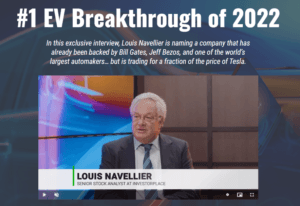
In this teaser, here's his core claim: lithium-ion is tapped out and a “holy grail” solid-state design will upend EVs—cheaper, faster-charging, safer—and mint outsized winners. It’s the familiar “master key” setup we’ve seen before (think the hype cadence from Mizrahi’s lithium teaser).
First, the clues Navellier drops before any names:
- Backing from “Bill Gates and Volkswagen,” share price “under $25.”
- A second play framed as “China’s most promising EV” and among the first there with a solid-state-style pack.
- Market size chest-thumpers (solid-state to ~$87B), with promises of 80% more range, two-minute charges, and lower costs.
How the reveals line up:
- Those Gates/Volkswagen breadcrumbs point straight to QuantumScape (QS)—Volkswagen has been the strategic backer and recently tightened its commercialization pact around QS tech (updated VW-QuantumScape deal here), underscoring the tie-up.
- The China hint fits NIO (NIO), which has repeatedly talked up a 150-kWh semi-solid/solid-state–style pack timeline (Q4 2022 in earlier guidance).
- A third pick is teased but not actually clued—nothing in the presentation pins it down.
Bottom line: it’s the classic “next-gen battery will make today’s standard obsolete” pitch. Solid-state is promising, but timelines keep slipping, and commercialization is still a slog. Treat the theme like a long-dated tech option, not a near-term sure thing.
>> Read the full write-up here
His “New Oil Age” Plays
- Title of Teaser Presentation: “Expert Warns: Oil Shock Coming”
- Name of “Special” Reports: “5 Stocks for the New Oil Age”
- Promoted Under: Growth Investor

He tells us we’re at the front end of an oil supercycle, and a handful of U.S. producers could gush cash as prices rise. He leans on institutional forecasts that once floated the prospect of $200 crude—think Rystad and Goldman—to frame the upside runway, and then funnels that into a five-stock “New Oil Age” list. (Rystad and Goldman both discussed paths to $200 during the 2022 supply shock.)
Clues he drops before any tickers:
- The core theme is a U.S.-led “New Oil Age,” with domestic producers benefiting most.
- ESG pressures have starved traditional drilling of capital, helping tighten supply
- Post-pandemic “revenge activity” boosts demand—travel, events, you name it.
- Geopolitics (Russia/Ukraine) is accelerating Western investment in non-Russian supply.
- He favors low-multiple U.S. E&Ps with variable dividends and high oil leverage.
- One pick is paying a large special dividend tied to a merger close.
What those clues matched to:
- The #1 pick is Devon Energy (NYSE: DVN)—he actually names it. It fits the “domestic, oil-levered, low P/E, variable-dividend” mold he hypes in the talk.
- The special-dividend clue lines up with Oasis Petroleum (Nasdaq: OAS), flagged here for a $15 special dividend associated with its merger with Whiting Petroleum—again, exactly how he framed it.
- The remaining names in his five-pack aren’t revealed in the teaser, beyond saying they’re U.S.-based operators.
Here, Navellier actually names DVN and all but names OAS via that merger-linked dividend clue. If you buy the macro backdrop he cites—again, those 2022 $200 scenarios were real talking points at the time—then a basket of quality U.S. E&Ps at modest multiples isn’t the craziest idea. (Goldman did lift 2022 Brent targets on “unresolved supply deficit” language during that run-up.)
>> Read the full write-up here
“Big Bet” 5G Picks
- Title of Teaser Presentation: “One sector of the market is about to make a ‘quantum leap' in technology”
- Name of “Special” Reports: “5G Hypergrowth Portfolio: Six Stocks to Incredible Wealth”
- Promoted Under: Breakthrough Stocks

With this pitch, Navellier rolls out a sweeping promise: 5G is the “quantum leap” platform that will finally unlock AI, autonomous cars, AR/VR, and the Internet of Things—and his computers have flagged six small-cap winners that could “go 20x.” The setup is classic: frame a massive tech transition, hint at outsized past calls, and pitch access to a model portfolio via a high-ticket newsletter.
First, the clues (or lack thereof). He says:
- It’s an all-in bet on the 5G sector (not one stock).
- There are six small-cap picks in a “5G Hypergrowth Portfolio.”
- He promises at least one free ticker in the presentation… but never gives it, and offers zero stock-specific breadcrumbs (no contracts, geographies, revenue lines, or partner names).
That’s it. No tickers. No tells. The exposé notes the presentation ultimately withholds the promised “free pick,” leaving only the broad 5G thesis. For context, we’ve seen this 5G playbook before—from Michael Robinson’s “5G Aftershock Market” setup to Dylan Jovine’s “5G Arrow” angle—both heavy on macro promise, light on verifiable identifiers until paywall time.
On the tech itself: 5G’s real advantages are lower latency, higher capacity, and architectural changes (massive MIMO, beamforming, small cells)—useful for dense IoT and edge applications, but rollout realities have been uneven and often overpromised. If you want a grounded explainer of what 5G actually does for networks, this IEEE Spectrum series is solid and plain-English on beamforming and other 5G building blocks, and Investopedia gives a decent investor-level overview of how 5G differs from 4G and where the value might accrue. Worth remembering: the “1,000x faster” headline is not the day-one norm for most users, as performance depends on spectrum, density, and backhaul—hype tends to get ahead of deployment.
Bottom line: Navellier pitches a six-stock 5G basket but provides no usable clues to independently ID the names. The exposé fairly calls that out, and only mentions broad beneficiaries like chipmakers and network gear vendors as general ideas—nothing in the actual teaser pins down a specific company.
>> Read the full write-up here
Tilson & Navellier’s ‘Hyperscalable’ Companies
- Title of Teaser Presentation: “Two Wall Street Legends Are Making the Same Big Prediction”
- Name of “Special” Reports: “The Hyperscale: Why the Next Leap in Online Technology Could Make You 10,000% on the Best Little Stocks”
- Promoted Under: Whitney Tilson’s Empire Investment Report + Louis Navellier’s Breakthrough Stocks (bundle)

Here we have Whitney Tilson and Louis Navellier teaming up to say a “historic unveiling” on August 29 in downtown Houston will kick off the biggest moneymaking setup in three generations — powered by “Hyperscalability,” “Digital Twin” tech, and “Ambient Computing.” The sales hook: 10 small “hyperscalable” names that could supposedly run 10,000% over time. The offer is a two-newsletter bundle for $2,500, with the list tucked inside their special report.
First, the clues they actually dropped in the teaser:
- A date/place anchor — August 29 in Houston tied to an industrial XR/digital-twin conference.
- The themes: “Hyperscalability,” “Digital Twin,” and “Ambient Computing” (no tickers, no financial markers). For context, “digital twins” are real-time software mirrors of physical systems (factories, fleets, grids) — the corporate explainer version of what they’re pointing at.
…and that’s it. No contracts, locations, revenue bars, insider names, or customer lists to triangulate. The presentation leans on the concept that software-like economics (add users, costs barely budge) will mint the next Microsofts — but without any company identifiers.
What’s being teased:
- A 10-stock “Hyperscalable Portfolio.”
- The thesis: businesses that grow revenue much faster than costs, juiced by trends like factory digital-twins and always-on/“ambient” compute (think the computer fades into the background across devices and spaces). Wired has covered that “ambient intelligence” framing from the consumer side if you want a feel for it.
How we connected the dots:
- The Houston timestamp matches an industrial immersive/digital-twin event window in late August, which fits their “historic unveiling” drumbeat. That supports the teaser’s setting — but not any specific stocks.
- Beyond that, they shared no verifiable breadcrumbs. A reader later posted ten tickers in the comments (KOS–MTDR–TWI–RCMT–CLFD–DAVA–MRVL–UMG–SYNA–LNTH), but the article notes those were unverified and we’re not treating them as reveals.
Bottom line: we're not 100% sure. The themes (software operating leverage, cloud/edge + digital-twin buildouts) are real enough, but the pitch never gives the usual tells we use to ID names. If you like this lane, sanity-check anything “hyperscalable” with boring metrics — recurring revenue, gross margin durability, and whether growth actually outpaces headcount/opex — and remember how often marketers blur macro trends into one-ticket miracle lists.
>> Read the full write-up here
2020 Picks
“Netflix of 5G” Stock
- Title of Teaser Presentation: “Louis Navellier's Dow 200,000 Foreshock Summit”
- Name of “Special” Reports: “The Netflix of 5G”
- Promoted Under: Growth Investor
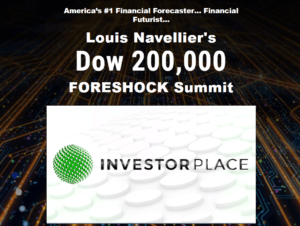
Louis Navellier dangles the usual moonshot—“6,000% or more”—by comparing one 5G beneficiary to Netflix post-4G. It’s the standard “own the tollbooth” angle we’ve seen before.
Here are the actual clues he drops before naming anything:
- “One of the leading owners of telecommunication towers in the U.S., India, Africa, and Latin America.”
- “Already signed contracts with AT&T, Verizon, Sprint, and T-Mobile.”
- “Owns and operates the real estate and infrastructure necessary for the 5G rollout.”
Those breadcrumbs line up neatly with American Tower (NYSE: AMT). AMT is the classic tower landlord REIT—its whole model is owning macro towers and leasing space to the big carriers, which is exactly the “picks and shovels” bet for denser 5G networks. Reuters noted AMT’s 2015 deal to control ~11,300 Verizon towers (plus 165 purchased), which boosted its U.S. footprint—right in line with the teaser’s “signed contracts” language. And for context on why towers matter to 5G at all: next-gen networks rely on a denser grid of macro sites and small cells to deliver higher speeds and lower latency. If you’re newer to tower landlords, AMT’s structure as a REIT (real estate investment trust) is standard for the space—worth a quick refresher on how REITs make money and pay out dividends.
Bottom line: the pitch isn’t for some secret microcap; it’s a mature, global tower REIT. That means steadier, rental-like cash flows—not a lottery ticket. It’s the same playbook we’ve seen in other 5G promos (e.g., the carrier/infrastructure angle in Jeff Yastine’s 5G teaser)—just with a Netflix wrapper.
>> Read the full write-up here
5G Turbo Button Stock
- Title of Teaser Presentation: “Trump's 5G Lockdown”
- Name of “Special” Reports: “The Netflix of 5G Stocks”
- Promoted Under: Growth Investor

Navellier leans on Washington tailwinds—specifically the Secure 5G and Beyond Act signed in March 2020—to argue a U.S.-led 5G buildout will mint fortunes and that one “Turbo Button” company sits in the perfect spot to ride it. (If you’re curious, that law directed a federal strategy for secure 5G rollout, not a blank check for one firm.) Here’s the actual statute summary. He’s selling a $49 Growth Investor sub with promises of multiple special reports and “urgent” updates.
Clues he dropped before naming anything: he calls the target “the King of 5G’s ‘Turbo Button’ technology,” says it’s enabling 5G “from multiple angles,” emphasizes “advanced semiconductor manufacturing” tied to “smart antenna” tech, and—most telling—says the company “controls significant market share in the process control and yield management systems market.” He also quotes a May 2020 CEO comment about 5G infrastructure demand boosting results and points to a ~100% stock jump in 2019.
Put together, that points to KLA Corp. (NASDAQ: KLAC)—the backstage player that doesn’t make antennas or modems, but does dominate inspection/metrology tools that chip fabs use to improve yields. Even Reuters describes KLA plainly as a supplier of “process control and yield management solutions” for the semi industry, which matches Navellier’s wording almost verbatim. The 5G angle is indirect but real: more radios, base stations, and RF silicon means more fab capacity—and more inspection gear. It’s the same picks-and-shovels pitch we’ve seen before, like Jeff Brown’s 5G-themed “Project Xi” or the way other gurus frame infrastructure as the “master key.”
Bottom line: the clues line up cleanly with KLA’s metrology/inspection franchise and the period chart action Navellier highlighted. Just remember the hype vs. reality spread—KLA benefits from 5G (and AI/foundry capex) but it’s not a pure-play “turbo button.” As we saw in Stephen Leeb’s 5G “Fix” teaser, 5G pitches love to exaggerate exclusivity for very non-exclusive plumbing.
>> Read the full write-up here
Who Is This Louis Navellier Guy Really?

When it comes to the ‘experts' we cover here at GBR, Louis Navellier is definitely one of the more legit ones we've seen.
Here's a little background, which really fits the bill.
Based in Reno, Nevada, he obtained a bachelor's degree from Cal State East Bay- College of Business & Economics, has been investing for ~35 years, and has been running his one advisory service, Growth Investor, since way back in 1998, which was after he started working with Phillips Investment Resources (the old name of InvestorPlace).
Not only this, but besides the newsletter teasers that brought you here, he is the Chairman & CIO of Navellier & Associates, through which him and his team manage nearly $1 billion (according to his latest Form ADV filing, the firm reported $836,043,453 in discretionary regulatory assets under management (RAUM) – filed July 4, 2025).
He has quite the background, no doubt.
Conclusion & Should You Buy Louis' Recommendations?
But… does this mean you should follow his recommendations?
If you're familiar with our site, GBR, then you know there's only one investment advisory service we recommend. This said, we're not telling you not to invest in his recommendations either.
There's quite a big fundamental difference in stocks Louis recommends and those of our top rec, which targets more ‘out-of-favor' stocks that not many are looking at rather than the stocks that are ‘hot'.
As always, do your own research and don't just blindly follow any investment ‘expert', no matter their background.
*Let us know if there's a stock teaser from Louis that you want us to cover that isn't on the list!*

